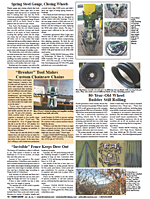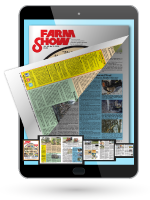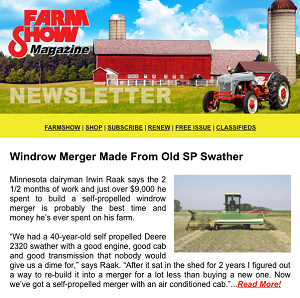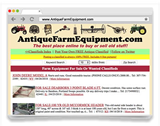Farmall Repowered With V-8 Chevrolet Gas Engine
 ✖  |
"It makes an ideal second tractor for pulling hay or forage wagons and for plowing snow," says Paul Thomas, Hollsopple, Penn., who, with the help of son Stan, repowered a 1951 Farmall M with a Chevrolet 350 cu. in. V-8 engine. They also connected the car's 3-speed automatic transmission to the Farmall transmission and fitted the tractor with a home-built cab.
"It has plenty of power for work on hills and runs at speeds from a slow crawl up to 40 mph on the highway," says Thomas.
Repowering Farmalls is nothing new for Thomas, who repowered an old F20 with a V-8 gas engine about 15 years ago.
Thomas paid $200 for the Farmall M which had a seized-up engine. He removed the engine and used 2 by 4-in. steel box tubing to build a frame that would hold the new engine and transmission, extending the tractor's overall length by 21 in. and moving the hood and fuel tank forward. The front driveshaft yoke on the Chevrolet transmission was modified so it could be hooked up to the universal joint on the Farmall transmission. He used the Chevrolet power steering pump to supply live hydraulic power to remote outlets on back of the tractor and to a hydraulic lift cylinder mounted on front. He needed bigger rear tires to take advantage of the extra horsepower so he split the original wheel rims in half and added 4 in. to widen them out, then mounted 16.9 by 38 tires. Fluid was added to increase traction as well as overall weight.
He modified the drums on the original "band" style brakes by welding front brake rotors from the Chevrolet disc brakes onto them.
"The tractor doesn't have a 3-pt. hitch, but it has enough hydraulic power to raise or lower a 12-ft. disk," says Thomas. "We use the front-mounted cylinder to operate two different snowplows. One is a straight blade that can be angled from side to side by a separate cylinder. The other is a V blade plow that we use when the going gets tough. We use tire chains for extra traction.
"We can shift the Farmall transmission by simply putting the automatic transmission in neutral. However, we usually keep the 5-speed transmission in 5th gear and use the 3-speed automatic transmission to adjust speed. There are 15 forward speeds
and three reverse.
"The pto has three speeds. To use it we put the Farmall transmission in neutral, then shift the automatic transmission into gear. To stop the pto, we just idle down until the automatic transmission stops.
"The cab has a heater, defroster, windshield wipers, and an AM-FM radio. We used box steel tubing to make a rollbar for the cab, then added sheet metal and glass windows. The two doors on back can be lifted off and all the windows crank out. We added a hand-operated throttle that makes it easier to unload forage wagons from the ground."
Contact: FARM SHOW Followup, Paul S. Thomas, R.D. 2, Box 394, Hollsopple, Penn. 15935 (ph 814 479-7889).

Click here to download page story appeared in.
Click here to read entire issue
Farmall Repowered With V-8 Chevrolet Gas Engine ENGINES Engines 19-2-17 "It makes an ideal second tractor for pulling hay or forage wagons and for plowing snow," says Paul Thomas, Hollsopple, Penn., who, with the help of son Stan, repowered a 1951 Farmall M with a Chevrolet 350 cu. in. V-8 engine. They also connected the car's 3-speed automatic transmission to the Farmall transmission and fitted the tractor with a home-built cab.
"It has plenty of power for work on hills and runs at speeds from a slow crawl up to 40 mph on the highway," says Thomas.
Repowering Farmalls is nothing new for Thomas, who repowered an old F20 with a V-8 gas engine about 15 years ago.
Thomas paid $200 for the Farmall M which had a seized-up engine. He removed the engine and used 2 by 4-in. steel box tubing to build a frame that would hold the new engine and transmission, extending the tractor's overall length by 21 in. and moving the hood and fuel tank forward. The front driveshaft yoke on the Chevrolet transmission was modified so it could be hooked up to the universal joint on the Farmall transmission. He used the Chevrolet power steering pump to supply live hydraulic power to remote outlets on back of the tractor and to a hydraulic lift cylinder mounted on front. He needed bigger rear tires to take advantage of the extra horsepower so he split the original wheel rims in half and added 4 in. to widen them out, then mounted 16.9 by 38 tires. Fluid was added to increase traction as well as overall weight.
He modified the drums on the original "band" style brakes by welding front brake rotors from the Chevrolet disc brakes onto them.
"The tractor doesn't have a 3-pt. hitch, but it has enough hydraulic power to raise or lower a 12-ft. disk," says Thomas. "We use the front-mounted cylinder to operate two different snowplows. One is a straight blade that can be angled from side to side by a separate cylinder. The other is a V blade plow that we use when the going gets tough. We use tire chains for extra traction.
"We can shift the Farmall transmission by simply putting the automatic transmission in neutral. However, we usually keep the 5-speed transmission in 5th gear and use the 3-speed automatic transmission to adjust speed. There are 15 forward speeds
and three reverse.
"The pto has three speeds. To use it we put the Farmall transmission in neutral, then shift the automatic transmission into gear. To stop the pto, we just idle down until the automatic transmission stops.
"The cab has a heater, defroster, windshield wipers, and an AM-FM radio. We used box steel tubing to make a rollbar for the cab, then added sheet metal and glass windows. The two doors on back can be lifted off and all the windows crank out. We added a hand-operated throttle that makes it easier to unload forage wagons from the ground."
Contact: FARM SHOW Followup, Paul S. Thomas, R.D. 2, Box 394, Hollsopple, Penn. 15935 (ph 814 479-7889).
To read the rest of this story, download this issue below or click
here to register with your account number.







